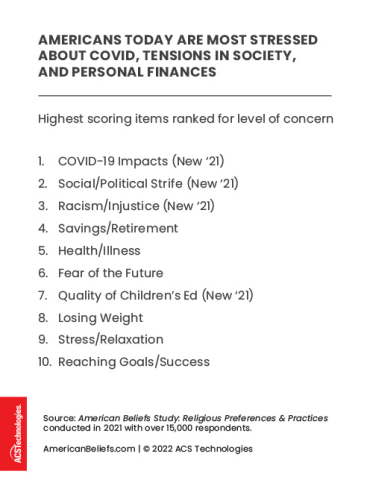COVID-19, Social Tensions, and Finances Rank as Biggest Concerns
Americans feel concerned about a lot of things. They feel stressed or irritated about what’s happening in the country. They feel freaked out or bothered about what’s happening in their lives. Is the national level of worry rising or falling? In short, it’s rising – but it’s not as simple as that. The American Beliefs Study sorted out where concern is rising most seriously.
This research asked a carefully-designed, representative sample of 15,000 Americans to indicate their level of concern for 44 factors that impact them, some of which relate to the country overall and some of which relate to their personal lives. For each item, they rated their concern on a five-point scale from ‘no concern’ at the bottom through ‘high concern’ at the top. In between were ‘slight,’ ‘periodic,’ and ‘escalating’ concerns.
The same study was conducted four years ago with the same kind of sample so that the results can be confidently compared. Ten of these 44 items were new to the 2021 study. That leaves 34 items that measure where Americans are more concerned – or less concerned – than four years ago.
There are various ways this could have sorted out. Maybe Americans feel the same level of concern as before for most of these items, or maybe Americans feel less concern than before for most of them. In fact, respondents felt greater concern than four years ago for three of every four items on the list (26 of the 34).
So the level of concern, or stress, that Americans are feeling is rising for most of what they face in life and society. More than that, for many of these items the level of concern rose at a very steep rate in the last four years.

Steep Rise
Broad social indicators like this don’t usually see a rise of five or more percentage points in such a short span of time. Here are the seven important issues where Americans’ level of concern saw such a steep rise.
It’s not just that Americans are worried, fearful, stressed, depressed, lonely, and insecure. They are acutely more worried, fearful, stressed, depressed, lonely, and insecure than just four years ago.
This sounds like bad news. But there is also good news. We know it as the Good News, the gospel of Jesus Christ. The gospel offers fortitude instead of fear, delight instead of depression, love instead of loneliness, and inner peace instead of insecurity. Jesus said,

Do not be anxious … your heavenly Father knows that you need [these things] … But seek first the kingdom of God and his righteousness, and all these things will be added to you. (Matthew 6:31-33, ESV).

The promises of God provide reassurance and hope where American emotional stress is rising most rapidly.
As worry, fear, and anxiety grow in our country, the need for what the Church has to offer also grows.
Key Findings:
1. The top three issues Americans are most concerned about today are the COVID pandemic, social/political discord in the nation, and their own financial futures.
2. For most social and personal issues, Americans’ level of concern has grown in the past four years.
3. Concern among Americans is rising fastest on issues such as health, the future, stress, caring for aging parents, depression, time pressures, and loneliness.
Ideas for Your Church:
1. Talk with the people in your church who provide pastoral care to the flock in one way or another. Ask about what points of concern, fear, or worry come up most often when they talk to people.
2. Think and pray about the issues that people in your community, outside the walls of your church, are most stressed about . And then pray about how you should respond.
3. See if you can generate creative ideas on how to show your community that your church is a good place to come and find answers to what Americans are most concerned about.
4. In light of this study, consider how your existing programs meet the life concerns prevalent in the neighborhoods you serve. Look for ways to build ongoing relationships with your neighbors that address these prominent concerns.
About this study
This online study among 14,942 American adults was conducted by Campbell Rinker for ACST from October 2020 through February 2021. Results were balanced by US region, 19 ‘Mosaic’ demographic clusters from Experian, and weighted by age to align with known population characteristics. The study carries a maximum margin of error of ±1.97% at the 95% confidence level within any US Census region. A comparative 2017 study involved the same size audience.
About the Authors
Dirk Rinker is president and CEO of Campbell Rinker. Which has been a leading market researcher for nonprofits since the early 1990s. He has designed and implemented research projects for hundreds of prominent mission organizations, charities, universities, and museums in the U.S. and internationally – helping clients understand and act on the attitudes, motivations, and perceptions of their valuable constituencies.
Michael Jaffarian is a writer, researcher, and consultant to nonprofits. He and his wife were missionaries for 33 years, serving in Singapore, Virginia, Los Angeles, and England. Most of his ministry has been in global mission research. He has studied and written on growth trends among tens of thousands of Christian denominations globally.


